

|
|
|
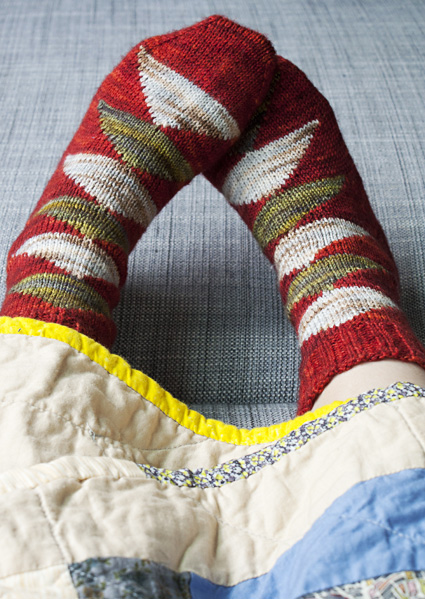
Confession: I've only ever made one quilt. My sewing isn't quite as good as my knitting, but lately I've been losing time wandering the aisles of the fabric store, just soaking in all the color and pattern. I've spent hours reading online tutorials and bookmarking inspirational quilt tops, and have been particularly drawn to two specific but somewhat opposite types: modern and clean designs that emphasize geometry, and humble charm quilts that have a well-worn and homespun feel. Making room to sew a quilt is a daunting task in our tiny ranch house, so naturally I turned to yarn instead of fabric. The resulting socks are a translation of a traditional flying geese design, knit one-triangle-at-a-time by using short rows. Depending on the yarn chosen, the final result can be either graphic or scrappy, making these a versatile option for both gift-giving and stash-busting. |
||
 |
Tweet
 |
|
|
SIZE |
|
|
FINISHED MEASUREMENTS |
|
MATERIALS Notions |
| GAUGE |
| 30 sts/42 rounds = 4 inches in stockinette stitch |
|
PATTERN NOTES |
|
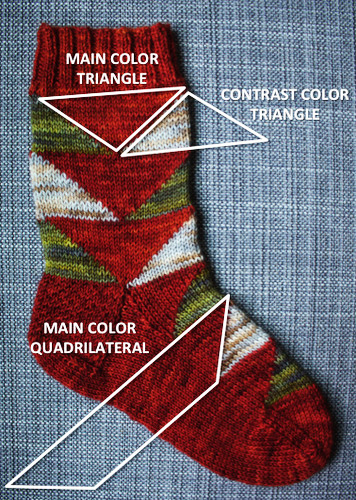 When knitting Contrast Color Triangles, alternate between CC1 and CC2 as shown. This pattern uses a stretchy cast on. You can use the Long Tail or Jeny's Stretchy methods:
Pick up and Purl: To pick up and purl, insert the tip of the right needle from the back (RS of fabric) towards you (the WS of the fabric); wrap the yarn as is to purl and take the new stitch back through to the RS of the fabric. Kitchener Stitch Working Floats Together with Stitches: Working Wraps Together with Wrapped Stitches:
|
|
DIRECTIONS 
Using MC and a stretchy cast on method CO 52[60, 68] stitches. Distribute sts across needles as you prefer and join for working in the round, being careful not to twist. Ribbing round: [K2, p2] around. Work ribbing as set for 15 rounds total. Next round: Knit. Break yarn, leaving a tail to be woven in later. Leg In the first and third sections CC1 is used for the front Contrast Color Triangle, and CC2 for the back Contrast Color Triangle. In the second section CC2 is used for the front, and CC1 for the back. This alternating pattern continues for the rest of the pattern. First Main Color Triangle Size L Only: Size M and L: All Sizes: Break yarn, leaving a tail to be woven in later. Set up for second Main Color Triangle: Reorient your needles so that the 25[29,33] unworked stitches are on your needle with RS facing. Add one stitch on each side from the previously worked stitches, so that you now have 27[31,35] stitches ready to be worked. Turn so that WS is facing. Work as for first Triangle. 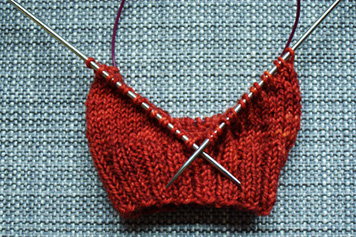 To set up for contrast triangles, your needles must be pointing in a V shape towards the center stitch of the gap you need to fill (see image at right). With RS facing, reorient your needles so that 13[15, 17] stitches are on your right hand needle, 14[16,18] stitches are on your left hand needle, and the remaining 25[29,33] stitches are held -- on another needle or holder. The center stitch of the gap (the lowest point) should be the first stitch on your left hand needle. Work the first Contrast Color Triangle with CC1 as follows: All Sizes: Size M only: Size L only: At this point, the RS is facing, and your stitches should be arranged as follows: 1 MC st, 25[29, 33] CC stitches, and 1 MC stitch; the final MC stitch is wrapped with the contrast color. Break yarn. Turn so that you're facing the other side of the sock, reorient your stitches as indicated above, and work a second Contrast Color Triangle with CC2. Once the two Contrast Color Triangles are complete, start another tier, Main Color Triangles first. 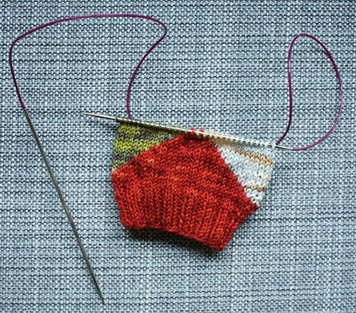 Turn so that WS is facing, and follow instructions for Main Color Triangle above. Repeat another Main Color Triangle on the opposite side as before. Once both MC triangles complete, work Contrast Color triangles as before, ensuring that you alternate so that CC2 is below CC1 on the front, and CC1 is below CC2 on the back. Work a third tier as for the second, working CC1 again on the front, and CC2 again on the back. Heel Flap Using MC: Repeat Rows 3-6 5[6, 7] more times, and work Rows 3 & 4 1[0, 0] more times. 28[30, 34] rows total. You will have 14[15, 17] slipped stitches on each side of your heel flap. 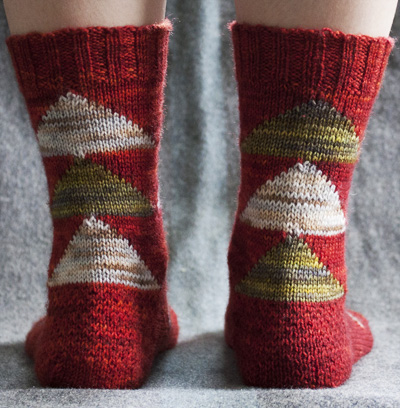 Row 1 [RS]: K18[21, 24], SKP, turn. Row 2 [WS]: Sl1, p9[11, 13] p2tog, turn. Row 3 [RS]: Sl1, k9[11, 13], SKP, turn. Row 4 [WS]: Sl1, p9[11, 13] p2tog, turn. Repeat Rows 3-4 until all the stitches from the heel flap have been worked. RS is facing, and 11[13, 15] sts rem. Break yarn.GUSSET Reorient your needles so that the center stitch of the contrast triangle on the instep is the first stitch on your left hand needle. Turn so that WS is facing. Using MC: Row 2 [RS]: Sl1, k11[13, 15], pm, k2tog, k35[39, 45], SSK, pm, k 11[13, 15], w&t. Size S only: Size M only: Size L only: You should now have 52[60, 68] stitches remaining. Break yarn. 
From here, you'll work Contrast Color Triangles on the top of the foot, and Main Color Quadrilaterals on the sides/soles of the foot. Main Color Quadrilateral Reorient needles with RS facing so that the center stitch of the last Contrast Triangle is the rightmost stitch on your left hand needle. Turn work to WS facing. 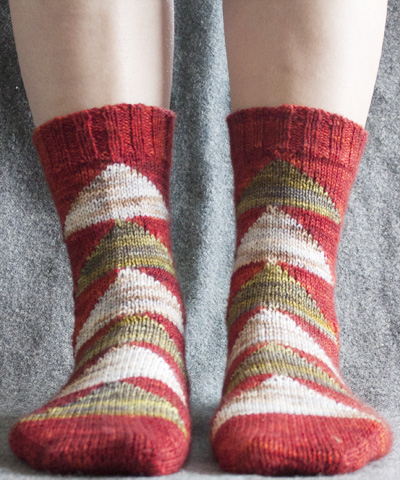 Row 13 [WS]: Sl1, p27, w&t. Size M only: Size L only: Break yarn. Continue to work Main Color Quadrilaterals and Contrast Triangles until you are anywhere between 3[3, 3.5] and 1.5[1.5, 1.75] inches away from the end of the foot, ending with a Contrast Triangle. After the final row in the Contrast Triangle, with RS facing you should be in position to work across the instep. Using MC, sl1, then knit even until foot measures 1.5[1.5, 1.75] inches less than desired full foot length. Shape toe: Repeat Rounds 1 & 2 until 28 stitches remain. |
|
FINISHING |
| ABOUT THE DESIGNER |
|
She lives Pittsburgh, Pennsylvania, with her husband and their imaginary French Bulldog. |
|
Pattern & images © 2013 Lacey Volk. Contact Lacey |